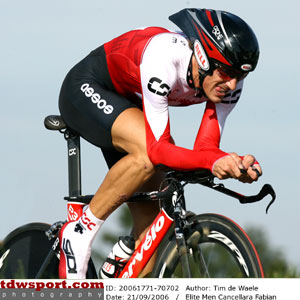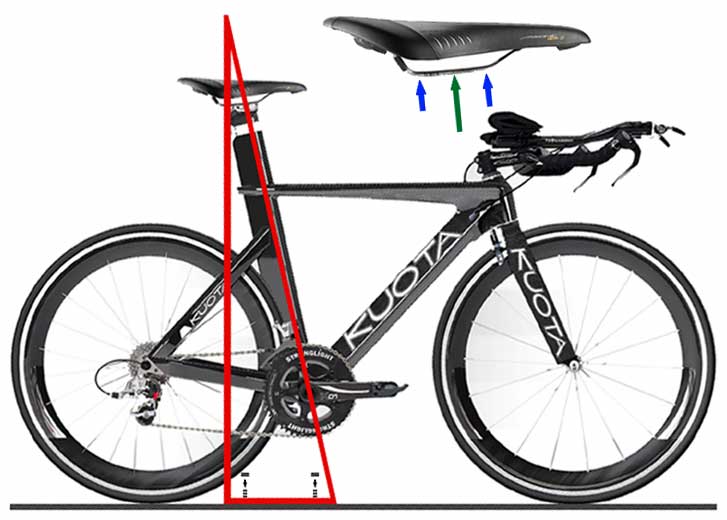X/Y Rules in an Angular World

I'm often asked to fit UCI-rule-encumbered athletes to their bikes, and this trend has stepped up during 2007. One reason: After blabbing for two decades about my timed racing fitting theories it appears (lo!) they may in fact be sound (the CSC team riders the auricular example if results speak loudest).
Another reason is that in my country (USA) equipment used by those who race bicycles must conform to UCI technical rules (triathletes are exempted from this).
Up through the last day of 2007 this is not the case. Even in a pro race, riders were free to ride under a different set of rules, as long as the race was not on the international calendar (those racing this year's Tour of California were subject to vastly different technical requirements than those racing in the Redlands Classic).
No longer will this be so. Highly categorized racers competing in National Racing Calendar events (Redlands Classic, for example) will fall under these new rules. Down-category and masters riders are also subject to the UCI rules at national championships and races that qualify them for international competition. Also, records will likely not be recognized if set on non-UCI-compliant equipment.
"So what?" you say. "As long as everyone has to race by the same rules, the playing field is level."
Theoretically so, but upon closer inspection this turns out not to be the case. In fact, both the rules as they are written, and the implementation of these rules, is enormously arbitrary and unfair. Let me lay out the problem, and then recommend its exceptionally easy solution.
As any high-level triathlete knows, fore-aft placement of the saddle is exceedingly critical, and riding with aero bars is not optimized if the saddle is too rearward. Of course, this is true of road riders on their mass start bikes as well, but the specific UCI rule governing this (1.3.013) is designed for road riding, not for time trialing with aero bars.
Let me put it this way. What would cyclists say if the rule was backwards? That is, if the rule was the converse of its current configuration? What if the nose of the saddle could be no further behind the bottom bracket than 5cm?
Cyclists would be fine with that "conversely stated" rule for timed racing. But what of road racing? It depends on the rider. Those under 5'6" would have few if any problems. But what of the 6'1" rider? What if he must position the nose of his saddle no further rearward than 5cm behind the BB for mass start racing? He'd be forced to sit off the back of the saddle, to achieve a hip position close to that which he gets when riding with the nose of his saddle 7cm or so behind the BB. If the rule read that way, the tall rider would feel quite discriminated against.
That's precisely the problem with the current UCI rules. Except with the way the rule is written, and for timed racing, it's the short people who're being discriminated against. Instead of riding with their trunks well off the back of the saddle, as in my faux rule above, they're riding well forward of the saddle, to the degree that special saddles are manufactured just to accommodate this ill-conceived rule. And if the tallest of the UCI-specific riders resort to this sort of cheater saddle, how disenfranchised must the shorter riders be?
I am often asked to position members of entire teams, and I am flying over to France in January to do just that for a Division I squad. Some of those riders will have saddle heights, measured from the BB to the top of the saddle, of 70cm. A rider 5'8" (172cm) might have a saddle height about like this. Another rider 6'2" tall (188cm) might have a saddle height of 80cm. These two riders, with the nose of the saddle 5cm behind the BB, will be riding with seat angles of 74.5 degrees and 76.5 degrees respectively (high school trigonometry will demonstrate this). Were the taller rider forced to ride the seat angle the shorter rider is confined to, we'd limit him to riding with his saddle 7cm behind the BB. Conversely, were the shorter rider granted the benefit of riding the same seat angle granted the taller rider under the current rules, his saddle nose would be 2mm behind the BB.
In other words, when Gilberto Simoni mounts his bike for a time trial, he's riding at a significant disadvantage compared to Dave Zabriskie or Fabian Cancellara. It's assumed that larger riders out-time-trial smaller ones because power on a flat road more than overcomes the increase in frontal area. I submit this is only part of the delta. The rest is explained by the huge inequity in the rules that grossly cripple a shorter rider's ability to compete on — no pun intended — a level playing field.
But wait! There's always the morphological exception! That's built right into the rules. The problem with the "ME" is that anyone can ask for this test — the tall riders included — and everyone who asks for it passes it (if you know how to "take" the test "correctly").
One point of urgency (for me) is that the UCI's commissaires have an annoying habit of discriminating against masters athletes. Any U.S. athlete who goes to Master's Worlds has heard, "We don't grant morphological exceptions to Masters racers." So, while on paper the rules do allow some equalization for a relatively few athletes competing at the highest levels, the globalization of this rule means that January 1 upcoming tens of thousands of short cyclists will now be getting the short end of the stick. Many do not understand what awaits them — just wait until they find out.
So, that's the problem: You can't apply a rule designed around an X/Y axis to the angular reality of cycling. Let's talk about the solution.
And this solution is exceptionally easy. The UCI should simply enforce a seat angle limitation. It can choose whatever it wants. It can limit seat angles, to 75 degrees, 77, 78, whatever it so chooses.

Rather than this being a difficult measuring protocol on race days, it's actually easier than using the fixture in current use. Pictured is a schematic of what I call The Harp. It's lines are in red in the image, but in fact it's a couple of pieces of angle iron cut and welded at a right angle. The hypotenuse is a wire. You string the wire at whatever angle conforms to the UCI's choice of maximum seat angle. It's exceptionally easy and cheap to build, and to transport.
And it's very easy to use. You simply roll the bike up and on a platform onto which the Harp is bolted. I recommend a metal plate with two holes through which the bolts route when mounting the Harp to it. The platform itself doesn't even need to be level. You could measure a bike with the platform sitting on a 10 percent slope and it would not matter. Roll the wheels forward until the wire passes through the BB. If the middle of the saddle's rails are behind the wire, the bike is legal. Otherwise, it's not. I could measure the legality of bikes much more quickly with my method than commissaires now measure for conformity to the current 1.3.013.
This rule as I recommend it be rewritten, and its execution, is absolute. There is no morphological exception. There no ME test. There is no more gaming the test. There is no longer any time required to perform the test. There is no further discrimination between short and tall, and between men and women, as is now the case. The solution is quick, easy, cheap, and fair.
I recommend one further piece of equipment that each commissaire must have: a ruler. The one way to "game" this test is to produce a Pinocchio saddle, that is, one with an overlong nose. The UCI simply needs to add to its "new and improved" 1.3.013 rule that the nose of the saddle cannot protrude more than 18cm in front of a line passing through both the bottom bracket and the center of the saddle's rails. If the commissaire comes across a suspicious looking saddle, he simply pulls out his ruler and measures.



